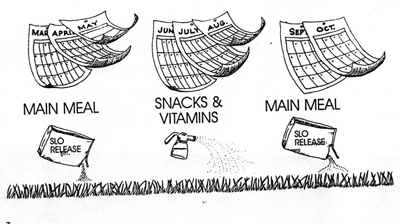Fertilizing Do’s and Dont’s
DO use a balanced slow-acting granular lawn fertilizer featuring water insoluable nitrogen.
DON’T feed grass that is stressed from drought, insect or disease or weird weather.
DON’T use a fertilizer that is combined with a pesticide or herbicide.
DO use fertilizer judiciously, in amounts prescribed on the package label.
DO fertilize in the fall to encourage strong grass root development.
DON’T spread fertilizer and lime at the same time.
DO use a tonic or bioactivator product if grass is stressed.
Supplemental Fertilization of Lawns
If your soil if sufficiently fertile that you need to fertilize only once a year, mid fall--before the ground freezes-- is the time. Then the nutrients are directed toward developing strong, deep grass roots, because the plants are approaching dormancy and are not generating new foliage. If part of your lawn is under deciduous trees, delay fertilizing until after falling leaves are removed or mulched into the lawn with a mulching mower. Note: Zoysia grass lawns are best fed in the spring and summer. April, May and July applications are best.
 |
If you plan to fertilize twice a season do it in the spring also. This will provide a nutritional boost at the start of the season before soil microbes are fully active and take over nutrition duties. It will also stimulate the grass to green up sooner than it would naturally. Spread fertilizer on parts of the lawn under deciduous trees about a month before their leaves come out.
Good Guy vs. Bad Guy
In other files, we have made a case for dealing with ants as mostly a beneficial insect except when it lives in the wrong place - in our lawn or in our house. The fire ant should be treated slightly differently. Fire ant colonies need large amounts of carbohydrates, proteins and fats to keep them going. They get most of their carbohydrates from eating plant sap and most of their proteins and fats from eating dead animals or those they kill. Fire ants are especially fond of insects. Yes, they have proven effective controls of a number of important insect pests in commercial agriculture including the boll weevil in cotton and the sugarcane borer in the sugar cane industry. But we are not farmers. We have a home landscape that we live in.
Fire ants do not belong in our home landscape. Besides attacking humans and pets they kill ladybug larvae and other important beneficial insects; they will harm buds, young fruit, roots of our landscape plants. They protect aphids for their nectar. They adversely affect the ecological balance of a yard by repelling mice, moles, rabbits, and killing invertebrates in the soil; and all these creatures have a role in a healthy home ecosystem.
In the final analysis, your landscape will be easier to protect from fire ants if you in fact have lots of other species of ants in residence as well. In a healthy yard ecosystem, fire ants seldom become the dominant ant specie. In yards where broad-spectrum insecticides have been used frequently (yards using lawn care services), the native ant population is very small and the fire ant can, and usually does, become the dominant specie. That means that in a healthy landscape, causing fire ants to move, seldom leads to their coming back. In an unbalanced ecosystem, the fire ants you caused to move will likely be back next year.

